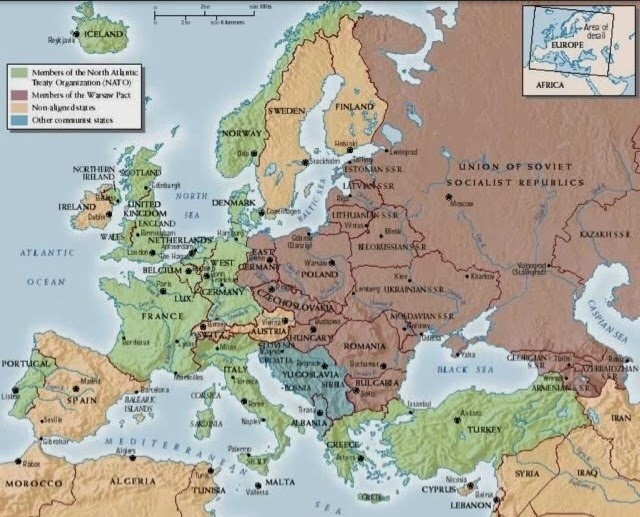In January 1981, this was the NATO v WarPac map of Europe (Spain didn't join NATO until 1982). As the year began, the situation seemed to be getting ever worse, from the Soviet viewpoint. The unrest in Poland, with the Solidarity movement as its focal point, was growing stronger by the day. The staunchly anti-Communist American President-elect Ronald Reagan was set to take office on January 20th. The situation in Afghanistan was slowly deteriorating and pulling in ever larger numbers of Soviet troops. Something had to be done!
The military exercise that had been held in late May and early June of 1980, called "Spring 80", had been the largest the Warsaw Pact had ever held, until the Fall, when it was repeated on a yet larger scale, "Soyuz 80". Intended to intimidate the Polish government and people, they appeared to have had little or no effect. So, the Soviets scheduled a second and even larger exercise, "Soyuz 81", for the 17th-22nd of March, to be taken part in by all WarPac countries, save Romania, which had refused to actively participate in the Warsaw Pact since 1968 as a protest at the invasion of Czechoslovakia.
As January arrived, it was not lost on Soviet planners that some of NATO's key members were at less than the pinnacle of military readiness. The United States was in the midst of a handover of power to the incoming new President. The old national security staff would be leaving and the new staff would need time before they were comfortable and efficient with their tasks. The West Germans had just begun a major restructuring of their army, some units having already received new equipment and training while other units still retained the old organization. The French continued to refuse to participate in NATO, being a member in name only, as they had been since 1966. The Greek military, after withdrawing from NATO in 1974, during the crisis in Cyprus, had returned to full cooperation only a few months previously. Very soon, the US forces in West Germany would begin to swell in preparation for the year's NATO military exercise, REFORGER 81 in September. If the Soviet Union was to upend the balance of power in Europe and, in the process, come to grips with their own growing problems, the time would never be better.
The upcoming Soyuz 81 exercise was only some two months away. The Soviets had already given notice of them to NATO headquarters in Belgium, as was customary, to forestall any misinterpretation of the necessary buildup and movement of troops and matériel. It would be the perfect cover. It need only be extended for an extra eight days.
In the most secure recesses of the Kremlin, a plan began to take shape. Would it be possible to put all things into motion in so little time? Directives were urgently sent to all KGB and GRU operatives in the United States; recruit a very particular sort of asset.
By the beginning of March, Reagan had taken office and the American hostages in Iran had been freed. The Soviet plan was almost ready. Everything would have to be timed precisely. There would be no margin of error. The Romanian leader, Nicolae Ceaușescu was summoned to Moscow and told bluntly that in what was to come, he could be an ally or an enemy. There would be no middle ground. Ceaușescu blanched at the implication and chose to be an ally. He immediately rushed back to Bucharest to reintegrate his military into the WarPac command structure. Similarly, Cvijetin Mijatović of Yugoslavia was told that while his participation was not expected, transiting Yugoslav territory or airspace might be necessary and his quiet acceptance was required. Like Ceaușescu, Mijatović chose survival.
Plans began to fall into place....

No comments:
Post a Comment